Foreword: The information in this article is what we know as of December 8, 2020 – the pandemic situation is quite fluid and information can change rapidly. I post daily updates on social media, and publish a weekly newsletter – click here for all my links and to subscribe.
Hello friends!
Thanks for joining us again as I try to sort through the confusing landscape of COVID-19 news and summarize as succinctly as I can each week.
Thank you as always for the incredible feedback.
I appreciate your positive comments and your inspiring words.
I have been dedicated to helping educate my patients and followers since the pandemic began (and far earlier on less stressful topics!).
I know there is tons of information to navigate and it is confusing and anxiety-provoking. With so many ‘experts’ preaching their ‘truth’, it can be overwhelming.
I am not an infectious disease specialist or public health expert, but I am a pediatrician and an emergency medicine physician, mom, and friend.
And I am happy to help.
I have been chatting quite a bit lately on social media (daily updates on IG @DrDinaKulik BTW) about the potential COVID-19 vaccines.
I am optimistic that a COVID-19 vaccine is coming.
I am incredibly impressed that real candidates have been created so quickly – we have come a long way with vaccine-science.
HOWEVER, I am seeing a movement that worries me.
A movement that says, ‘a vaccine is here and will save us all, throw away masks and don’t bother with social distancing, this won’t be needed anymore when we have vaccines.’
This is scary to me.
Very worrisome indeed.
It is keeping me up at night actually.
I feel strongly that we know how to prevent COVID infection and we should keep doing what we know until we are sure we have a vaccine that works, that provides reasonably long immunity, that is safe, short and long term, and importantly, can be rolled out across the world, to everyone who needs it.
Please remember to practice physical distancing, avoid indoor congregation, wear a mask whenever possible, and continue to practice diligent hand hygiene.
We also have to continue to improve our ability to test-contact trace-isolate.
I want this to be over as well.
Dr. Dina, how are we doing?
I am disappointed to say that we absolutely do not have things under control in Canada.
Here are the recent stats.
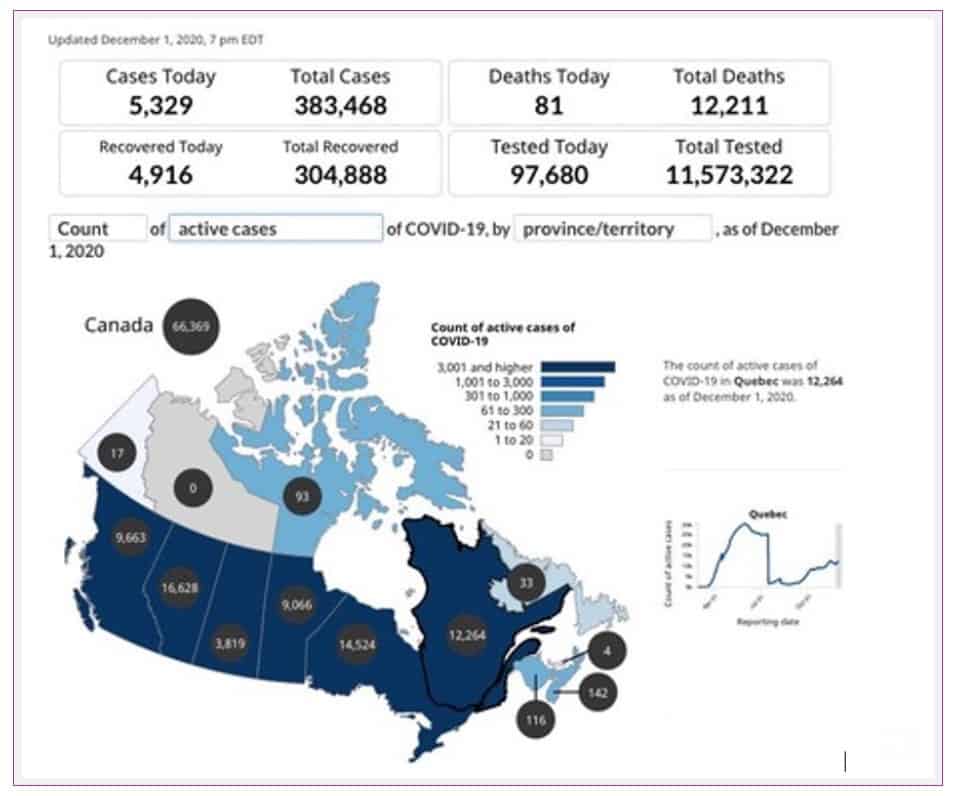
Ontario and Quebec still have tons of cases, but the real concerns now are Alberta, which is facing a true health crisis (Alberta has about ¼ the population of Ontario).
Many of us are very nervous about the growing case rate in the northern areas of the provinces and the growing case rate in the Territories.
Many Indigenous communities are facing a scary reality as infections rise and deaths increase.
I am not a politician, and I am not a public health expert.
But in studying successful countries’ response to COVID-19, I can say I am confident that a country-wide strategy, that is made with each province and territory in mind, that is cohesive and collaborative across Canada, is needed.
We need to act urgently and conservatively.
It is time to be strict and have crystal clear messaging.
We need each and every citizen to understand where we are, and where we are at risk of going, and what they should do as an individual, and within their community, to get this under control.
We need clear leadership and direct messaging.
Or we are in for a huge whooping.
How is the world looking?
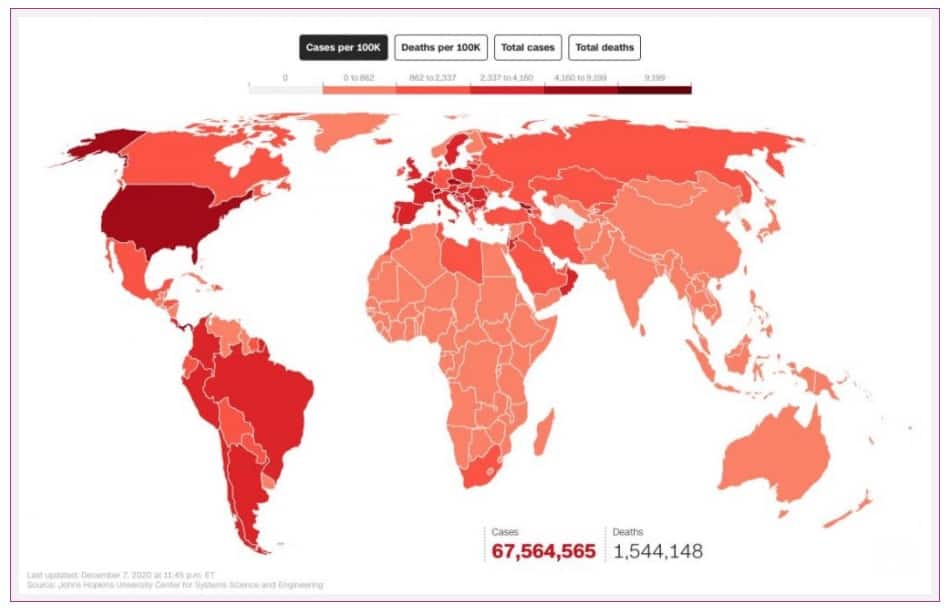
This is the world at the moment.
I won’t belabour the point I make weekly.
North and South America and Europe are not doing well.
Asia, Africa, and Oceana – high five.
If you want to read about how Africa and Australia are preventing these crazy waves, check out my previous newsletters here.
New Pandemic Projections
The Institute for Health Metrics and Evaluation (IHME) at the University of Washington’s School of Medicine released forecasts that incorporate the expected rollout of COVID-19 vaccines for all countries.
This assumes that the vaccine is highly effective at preventing COVID infections.
Of concern, the projections show that even with an effective vaccine, there will be a Winter surge of cases and we have a number of months to go before COVID-19 is controlled.
‘Ongoing continued vigilance to control the spread of the virus will be necessary for several months.’
According to the IHME,
‘The forecasts show that if mask-wearing increased to 95%, combined with expected vaccine rollout, approximately 66,000 lives could be saved, compared to a vaccine rollout scenario with current mask-wearing levels remaining the same … Especially in the Northern Hemisphere, it’s crucial for governments to impose or re-impose mandates that limit gatherings and require masks. Where the winter surge is driving spikes in infections, there will be many people who can still become infected and possibly die before the vaccine is fully rolled out.’
Here are some of the data from these projections, first Canadian data, then global.
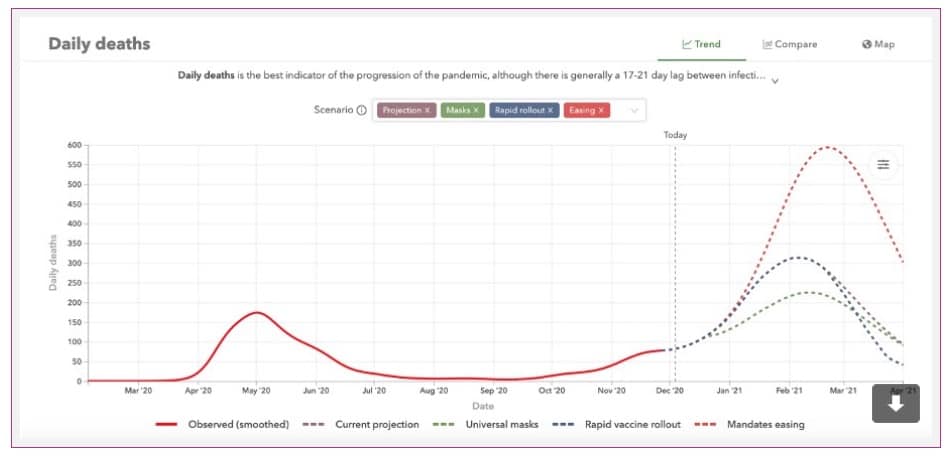
In this Canadian prediction, if we relax (‘easing’) we are at risk of 600 DEATHS each day.
Everyday.
You can see that rapidly rolling out COVID vaccines helps, but masks help even more.
And relaxing restrictions is clearly not the way to go.
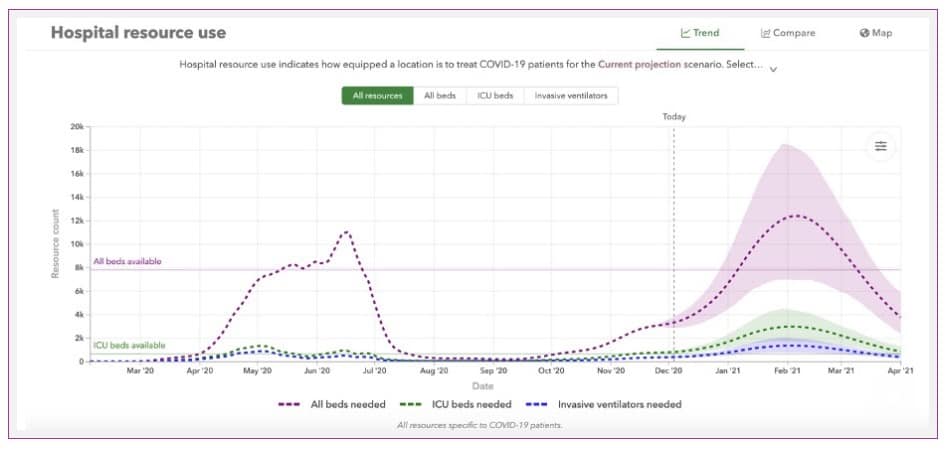
As a physician, this is a concerning graphic.
We don’t have infinite resources.
We don’t have infinite physical ICU beds.
We don’t have endless ventilators, nor staff.
We doctors, nurses, custodians, phlebotomists, porters, respiratory therapists, and the dozens of other members of the team cannot be cloned.
If we have more COVID cases, we have more deaths.
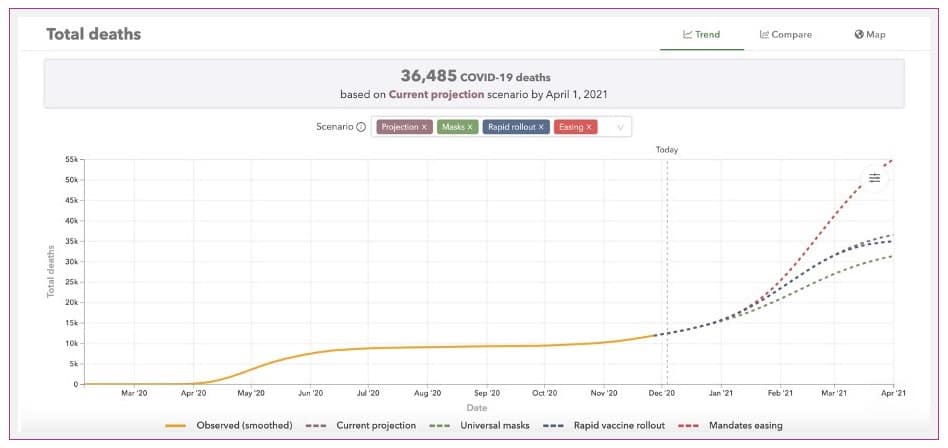
Finally, this is their projection (graph above) for the number of deaths in Canada.
Around 37,000 people are predicted to die from COVID-19 by April 2021.
Over 12,000 have died already.
Masks help.
Vaccines help a bit in the short term.
Relaxing is a bad plan.
Now let’s turn to the projections globally.
This is grim …
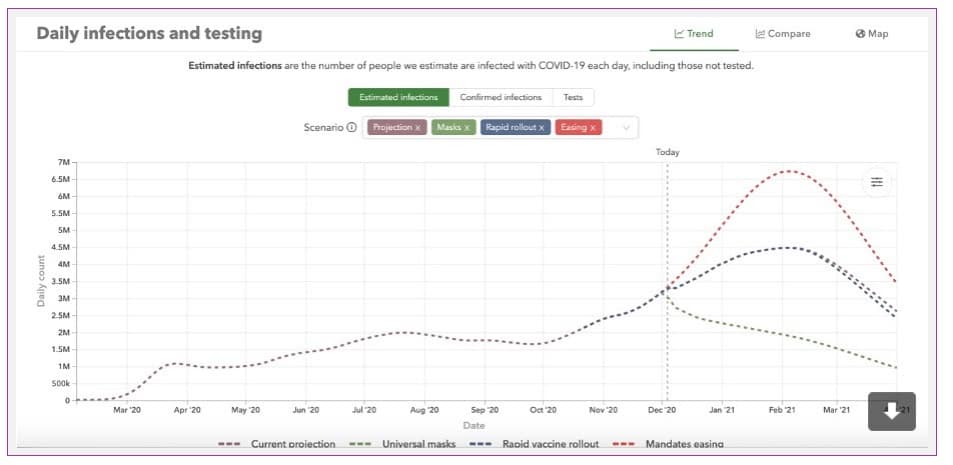
Keep in mind, this is infections confirmed EACH DAY.
You might rub your eyes and refocus.
Each day, we may see 4-6 MILLION NEW cases.
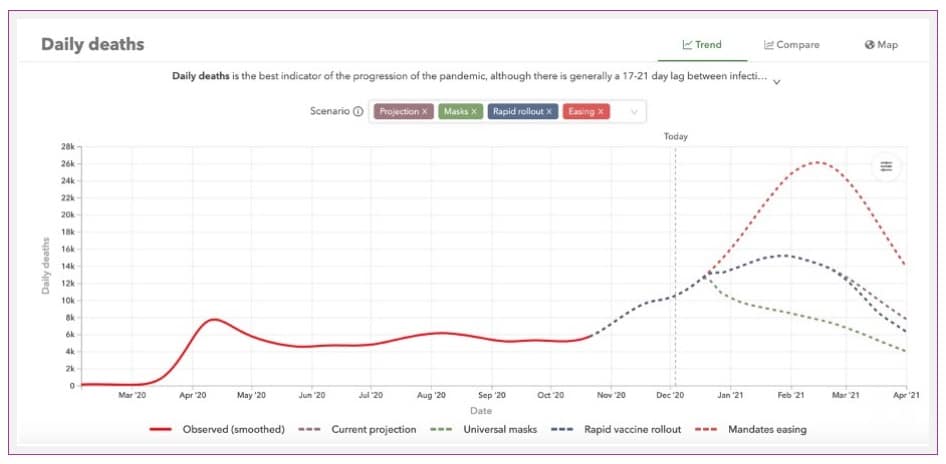
This is global daily deaths.
DAILY.
Can you imagine a small city of 20,000 people?
Imagine each and every day, a city this size is totally wiped out.
EACH.
DAY.
And incredibly scary for me:
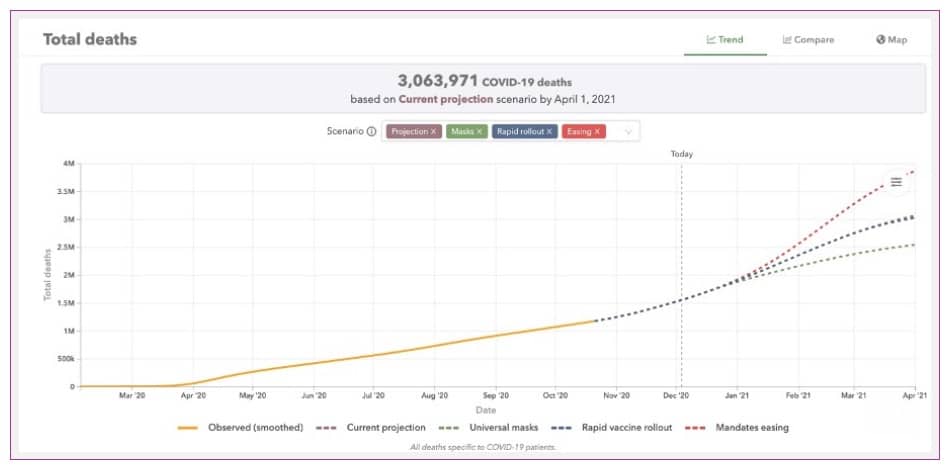
Please note that according to these projections, masks help far more than vaccine roll out in the short term.
And easing up on restrictions leads to many more deaths.
Can we relax restrictions if we all get tested?
I am asked countless times every day if we should all just get tested, and if we are negative, can’t we hang out together, without masks?
The answer is NO!
The PCR nasal swab test is quite good at detecting true positive cases.
99.99% of the time, positive means positive.
There are almost no false positives.
But the current stats show that the COVID-19 PCR nasal swab can miss up to 30% of infected people.
It is not perfectly sensitive.
Plus, if you are following the case rate each day, you know that there are ongoing backlogs for test results.
Earlier in the year, some people were waiting a week or longer to find out their test results.
We simply don’t have the lab capacity to test everyone and report results quickly.
So, the test is not highly sensitive, and we cannot test everyone in an expedient way – so we can’t rely upon it to make day-to-day decisions about how we move about in the world.
It should not be used to make decisions about who you see and how stringent you are with masking and distance.
Simply don’t take chances.
Please.
One day we may see more sensitive at-home rapid tests.
But right now, these rapid tests are less accurate and less sensitive than the PCR test.
We can rely on them even less to determine our risk for others on any given day.
One day, I hope.
What’s the story with Thorncliffe Park School?
Thorncliffe Park school is part of a provincial program that is testing students and staff in areas experiencing high rates of COVID-19.
The aim of the program is to identify what percentage of the student body is infected to reduce transmission of the virus.
Thorncliffe Park community currently is seeing a huge 16% test positivity rate, and asymptomatic testing at Thorncliffe Park Public School confirmed 19 new COVID-19 cases.
Interestingly, there were one or two positive cases in each of the 18 classrooms, as opposed to one large cluster in a class.
What can we learn from this?
We certainly need more data and more testing of asymptomatic people.
I have been worried about this since March – it is likely true that plenty of people have COVID-19 and are at risk of infecting others, and we have no idea.
If many people (in my estimate, most people) have no symptoms or very mild symptoms, but they are out in schools and daycares and workplaces, and we are not masking well, washing hands, or distancing, COVID will not settle.
Ok, what’s the good news?
Hmmm…
Let’s jump into my silver linings 😊
1. Connecting, like really connecting, with my patients.
I have always loved hanging out with my patients and their families. I am certainly an extrovert and I get energy from others. One benefit of COVID, and perhaps my openness and rawness in the media and social media about my feelings around the pandemic, is the ease that patients have in discussing important issues with me. I have thoroughly enjoyed chatting more with people about how my family is, how their family is, and how we are getting through this chaos together. The virus is humbling. It is bringing the entire world to the same ‘party’, with a common experience like never before.
2. Innovation and making improvements.
I, like many of you, have been purging and cleaning up since March. Perhaps it makes me feel in control somehow. Both at home and at Kidcrew, I am tidying, and streamlining, and making improvements. At Kidcrew we are working on policies and processes to make workflows faster and more efficient and better for patients. At home, I am really considering what we love and use and what can be better used by another family. Less clutter, more control.
3. Generosity.
Despite all the chaos in the world right now, and the mass amounts of anti-everything that I am bombarded with on social media, I also see a ton of generosity and support for others. From influencers supporting local businesses, to virtual charity events, to friends helping friends who are feeling crappy – many people have chosen to divert their attention from the overwhelm and stress to make other’s feel better. I applaud you!
That’s all folks.
Thanks for joining me again this week.
Please remember, we know how to prevent infection.
– Wash your hands.
– Wear a mask.
– Minimize contact with others outside your household, especially indoors.
– Stay home if you’re sick.
Be patient, and kind, and consider not just your own ‘personal liberties’ but also the health and safety, and lives, of your fellow community members, when you are out in the world.
Stay healthy and safe,

Dr. Dina Kulik

![[Dr. Dina News] IMPORTANT UPDATE re. VIRTUAL CARE](https://drdina.ca/wp-content/uploads/2021/01/dr-dina-kulik-kids-and-virtual-care-1a-400x250.jpg)
![[Dr. Dina News] COVID-19 Vaccine for Infants and Young Children.](https://drdina.ca/wp-content/uploads/2021/04/dr-dina-kulik-kids-and-vaccines-400x250.jpg)
![[Dr. Dina News] COVID-19 Vaccine for Infants and Young Children.](https://drdina.ca/wp-content/uploads/2022/04/DRD-1-400x250.jpg)






